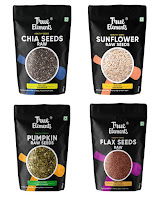Introduction:
For new mothers, the postpartum hair loss phase is challenging and life-changing and frequently presents several unforeseen difficulties. Even though this condition is typically temporary, many women look for solutions that work well to control and encourage hair growth during this time. We look at various postpartum hair loss products in this guide that are meant to help your hair heal and grow during this time.
1. Shampoos and Conditioners Without Sulfates:
Choosing hair care products without sulfates can help preserve the natural oils on your scalp and shield it from additional harm. Seek mild formulas that encourage a wholesome environment on the scalp.
 |
| Discover the power of biotin and collagen for fuller, healthier-looking hair Shop Now |
2. Shampoos for Hair Growth:
Biotin, caffeine, and ketoconazole are components used in hair development shampoos; these substances are thought to stimulate hair follicles and encourage regeneration. These products are designed to fortify already-existing hair and nourish the scalp.
3. Mineral and vitamin supplements:
Supplements with vitamins and minerals, especially those made to enhance hair health, are what many new moms turn to. These supplements frequently contain omega-3 fatty acids, biotin, and vitamin E. You must speak with a medical expert before starting a supplement regimen.
Including a wide variety of nutrient-dense plant-based foods in your diet will help promote hair development and general wellness. The following are some instances of vitamins and minerals that are crucial for healthy hair, along with vegetarian sources:
- Vitamin B7 (biotin):
Found in whole grains, nuts, seeds, legumes (particularly peanuts), and vegetables like cauliflower and sweet potatoes.
 |
| These raw seeds packed with vitamin E add nutrition to your daily routine. Shop Now |
- Vitamin E:
Found in almonds, sunflower seeds, broccoli, spinach, and different vegetable oils (including olive and sunflower oil).
- Iron:
Vegetarian sources of iron that are high in iron include leafy greens like spinach and kale, lentils, beans, tofu, and fortified cereals. Iron absorption is improved when vitamin C-rich foods are eaten with foods high in iron.
 |
| Nutrient-packed combo rich in omega fatty acids, perfect for a wholesome addition to your diet Shop Now |
- The Fatty Acids Omega-3:
Vegan omega-3 fatty acid sources include flaxseeds, chia seeds, walnuts, hemp seeds, and algae-based supplements.
- Protein
Plant-based protein necessary for hair structure can be found in legumes (beans, lentils, chickpeas), tofu, tempeh, quinoa, nuts, seeds, and whole grains like brown rice and oats.
- Zinc
Lentils, hemp seeds, cashews, pumpkin seeds, and chickpeas are vegetarian sources of zinc. Cereals that have been fortified and whole grains also help.
- Vitamin A
Vitamin A is abundant in carrots, sweet potatoes, spinach, kale, and other orange and dark green vegetables.
- Vitamin D
The body naturally produces vitamin D when exposed to sunlight, even when vegetarian diets are low in the nutrient. Certain fortified meals, such as cereals and plant-based milk, can also help.
4. Topical Minoxidil Treatments:
The FDA has approved minoxidil, an over-the-counter topical medication, to encourage hair growth. Some formulas are created especially for bald females. Before using minoxidil, speak with your doctor to be sure it's the right choice.
5. Essential Oils:
Essential oils that are said to be good for hair health include lavender, rosemary, and cedarwood. Products that blend these essential oils with carrier oils offer a practical means of nourishing the scalp and encouraging a wholesome atmosphere for hair development.
6. Leave-in Conditioners and Serums:
Frequently found in leave-in conditioners and serums designed to address postpartum hair loss include keratin, argan oil, and peptides. These products lessen breakage and encourage a smoother, more manageable texture by moisturizing and strengthening it.
7. Treatments for Proteins:
A key component of hair structure is protein. Protein treatments can strengthen the hair shaft and lower the chance of breaking. Seek for items with collagen or keratin that have been hydrolyzed.
Creating a protein treatment at home is a cost-effective and natural way to nourish your hair. Here's a simple DIY protein treatment using common kitchen ingredients.
Depending on the length and thickness of your hair, you can modify the quantity of this DIY protein hair mask. Here is a basic rule of thumb:
Greek yogurt and avocado protein hair mask ingredients:
- One ripe avocado
- Greek yogurt
- One tablespoon of coconut oil or olive oil
Guidelines:
1. Get the ingredients ready:
- Pit and peel the avocado.
- Smoothly mash the avocado.
- When the avocado is mashed, gradually add Greek yogurt until it becomes smooth and creamy.
- Add and thoroughly stir in coconut or olive oil.
2. Use:
- Wet your hair with Water
- Evenly distribute the mixture throughout your hair, working your way down to the tips from the roots.
3. Cover and wait:
- Use plastic wrap or a shower hat to cover your hair.
- For around thirty to sixty minutes, keep the mask on.
4. Shampoo and rinse:
- Use lukewarm water to complete rinse your hair.
- Shampoo your hair to remove any leftover mask residue.

